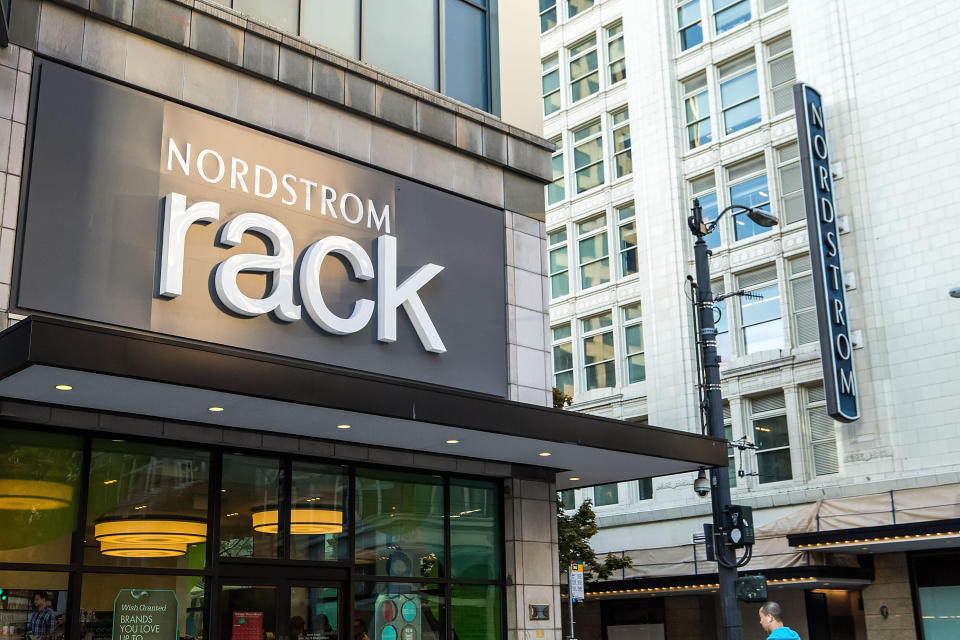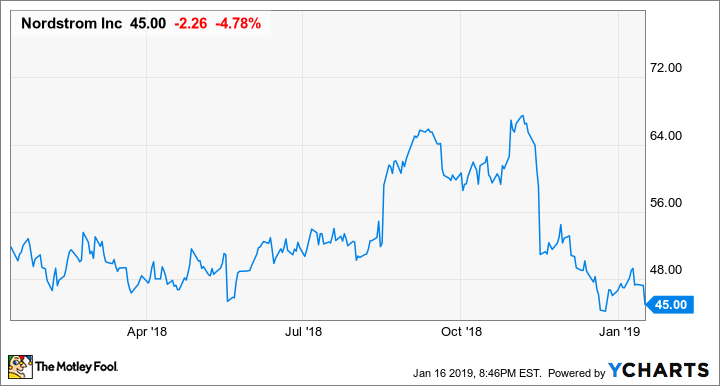Nordstrom Joins Its Rivals and Reports Subpar Holiday Season Sales
Department stores entered the 2018 holiday season with high hopes, thanks to strong economic conditions, including historically low unemployment and rising wages. Indeed, this favorable backdrop had already driven improved sales trends in the first few quarters of the year.
But a series of department store companies -- led by industry giant Macy's (NYSE: M) -- have reported disappointing holiday season sales this month. On Tuesday afternoon, Nordstrom (NYSE: JWN) became the latest retailer to report that sales growth slowed at its full-line stores during November and December.
Nordstrom joins the crowd
For most of 2018, Nordstrom seemed to be making a strong recovery from the slowdown that struck most department stores beginning in 2015. In the first nine months of the fiscal year, comparable-store sales rose 2.4%, consisting of a 1.9% increase for its full-line business and 3.4% comps growth for the Nordstrom Rack off-price concept.
In November, the retailer projected that sales growth would slow modestly in the fourth quarter, bringing the company's full-year comps gain to around 2%. Comp sales rose 1.3% in the combined November-December period, keeping the company on track to hit that target. But unfortunately, while the off-price business posted a healthy 3.9% comp sales increase, full-line comps inched up just 0.3%.

Nordstrom's off-price division is thriving, but its full-line stores are struggling. Image source: Nordstrom.
This full-line sales result was even worse than the 1.1% comp sales gain Macy's reported for the holiday season. Thus, it's not surprising that Nordstrom and Macy's are confronting the same problem of excess inventory right now. Both chains are taking additional markdowns this month to get rid of slow-moving inventory. That will hurt gross margin.
The good news for Nordstrom investors is that management still expects to reach the low end of its full-year adjusted EPS guidance of $3.55 to $3.65. By contrast, Macy's had to reduce its earnings forecast because of its holiday-season sales miss.
The outlook remains strong
Nordstrom may have suffered a setback during the holiday season, but it's still well positioned for long-term success. Most importantly, the company is steadily diversifying its revenue base away from mall-based full-line stores, which are being hurt by falling mall traffic.
Nordstrom's e-commerce and off-price operations already accounted for more than half the company's revenue by fiscal 2017. Those parts of the company are posting strong growth. Nordstrom is also poised to open the main portion of its Manhattan flagship store this fall, which will boost its full-line business outside the confines of a mall.
Meanwhile, the company continues to close underperforming full-line stores at a pace of roughly two per year. Over time, the performance of its mall-based stores should fade in importance for the company as a whole.
An opportunity for buybacks
Following the holiday sales update, Nordstrom stock fell 5% on Wednesday. This left it trading for around $45, close to a 52-week low. Shares have lost about a third of their value since early November.
Nordstrom Stock Performance, data by YCharts.
The benefit for long-term investors is that this sell-off should allow Nordstrom to repurchase a lot more of its stock. At its investor day last July, the company revealed plans to spend about $3.7 billion on share buybacks between fiscal 2018 and fiscal 2022. As of early November, it still needed to spend more than $3.5 billion to reach that goal. It also had lots of excess cash.
At the current stock price, $3.5 billion would be enough to repurchase about 45% of Nordstrom's outstanding shares. That alone would nearly double EPS. The company also has a good chance to grow its revenue and profit margin between now and 2022 as some of the massive investments it has made over the past several years begin to pay off.
Of course, if Nordstrom stays on track with its revenue and margin improvement goals, the stock won't remain below $50 for too long. But the more Nordstrom can shrink its share count while the stock is under pressure, the better off shareholders should be in the long run.
More From The Motley Fool
Adam Levine-Weinberg owns shares of Macy's and Nordstrom. The Motley Fool recommends Nordstrom. The Motley Fool has a disclosure policy.

 Yahoo Finance
Yahoo Finance 
